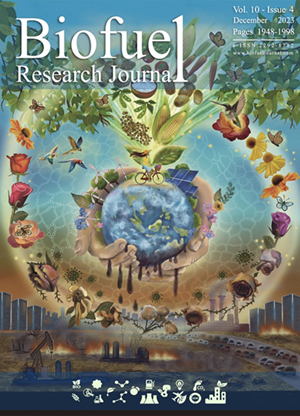米糠酸油的酶促酯化/酯交换反应及其对γ-谷维醇的回收
IF 11.9
Q1 ENERGY & FUELS
引用次数: 1
摘要
本研究从米糠酸油(RBAO)中回收γ-米甲醇,经过初始酶催化酯化/酯交换,选择性地将其甘油杂质转化为脂肪酸乙酯(FAEEs)或生物柴油。然后将γ-谷维醇去质子化,通过酸碱萃取从生物柴油中分离到水相中。在此,我们确定了不同的反应条件,即乙醇:RBAO的摩尔比、温度、反应时间、酶载量和搅拌速度,对甘油脱除程度、γ-米甲醇损失、游离脂肪酸(FFA)残留量和生物柴油含量的影响。在我们最合适的反应条件下(5:1乙醇:RBAO摩尔比,40°C, 24 h反应时间,10%wt加酶量,200 rpm搅拌),甘油脱除率高达100%,生物柴油产率相对较高(84%),γ-米甲醇损失率低至26%。此外,在剩余的稻谷醇中,用2-4 M乙醇NaOH溶液进行酸碱萃取,回收率高达94%。我们的研究结果表明,将酶促酯化/酯交换与随后的酸碱提取相结合,为同时生产生物柴油和从低成本的RBAO中回收γ-米甲醇提供了一种有效的替代方法。根据我们对技术经济和环境可持续性的分析,将目前的方法整合到米糠炼油厂将使该过程有利可图,并且使用的有毒化学品和能源最少。本文章由计算机程序翻译,如有差异,请以英文原文为准。
Enzymatic esterification/transesterification of rice bran acid oil for subsequent γ-oryzanol recovery
This study recovered γ-oryzanol from rice bran acid oil (RBAO), following an initial enzymatic esterification/transesterification to selectively convert its glyceride impurities into fatty acid ethyl esters (FAEEs) or biodiesel. γ-oryzanol was then deprotonated and separated from the biodiesel into the resulting aqueous phase via acid-base extraction. Herein, we determine the effects of varying reaction conditions, i.e., ethanol:RBAO molar ratio, temperature, reaction time, enzyme loading, and agitation speed, on the degrees of glyceride removal, γ-oryzanol loss, free fatty acid (FFA) remaining, and biodiesel content. Up to 100% glyceride removal was achieved with a relatively high biodiesel yield (84%) and γ-oryzanol loss as low as 26% under our most suitable reaction conditions (5:1 ethanol:RBAO molar ratio, 40 °C, 24 h reaction time, 10%wt enzyme loading, 200 rpm agitation). Furthermore, of the remaining oryzanol, up to 94% was recovered by the acid-base extraction with 2-4 M ethanolic NaOH solution. Our results suggest that a combination of enzymatic esterification/transesterification with subsequent acid-base extraction offers an efficient alternative approach to the simultaneous production of biodiesel and γ-oryzanol recovery from low-cost RBAO. Based on our analysis of techno-economic and environmental sustainability, integration of the present method into a rice bran oil refinery would make the process profitable, with the minimum use of toxic chemicals and energy.
求助全文
通过发布文献求助,成功后即可免费获取论文全文。
去求助
来源期刊

Biofuel Research Journal-BRJ
ENERGY & FUELS-
CiteScore
22.10
自引率
1.50%
发文量
15
审稿时长
8 weeks
期刊介绍:
Biofuel Research Journal (BRJ) is a leading, peer-reviewed academic journal that focuses on high-quality research in the field of biofuels, bioproducts, and biomass-derived materials and technologies. The journal's primary goal is to contribute to the advancement of knowledge and understanding in the areas of sustainable energy solutions, environmental protection, and the circular economy. BRJ accepts various types of articles, including original research papers, review papers, case studies, short communications, and hypotheses. The specific areas covered by the journal include Biofuels and Bioproducts, Biomass Valorization, Biomass-Derived Materials for Energy and Storage Systems, Techno-Economic and Environmental Assessments, Climate Change and Sustainability, and Biofuels and Bioproducts in Circular Economy, among others. BRJ actively encourages interdisciplinary collaborations among researchers, engineers, scientists, policymakers, and industry experts to facilitate the adoption of sustainable energy solutions and promote a greener future. The journal maintains rigorous standards of peer review and editorial integrity to ensure that only impactful and high-quality research is published. Currently, BRJ is indexed by several prominent databases such as Web of Science, CAS Databases, Directory of Open Access Journals, Scimago Journal Rank, Scopus, Google Scholar, Elektronische Zeitschriftenbibliothek EZB, et al.
 求助内容:
求助内容: 应助结果提醒方式:
应助结果提醒方式:


